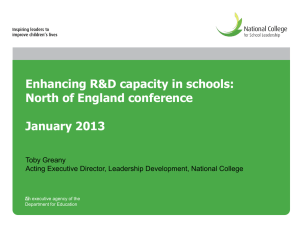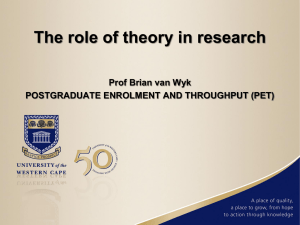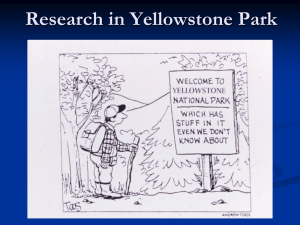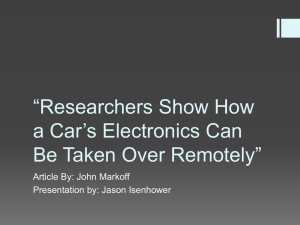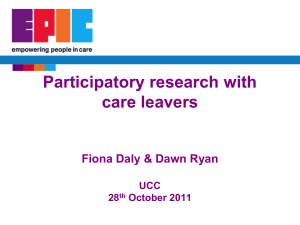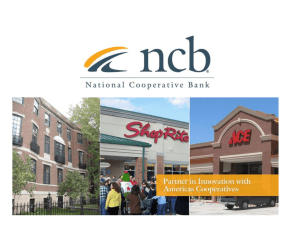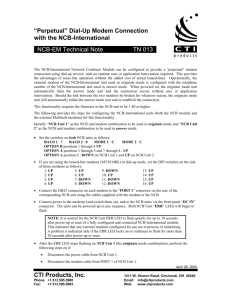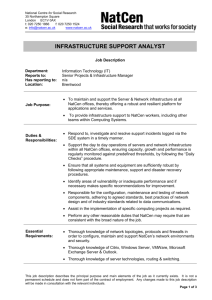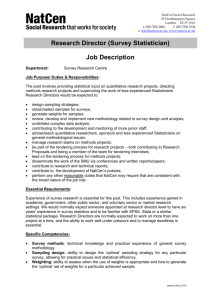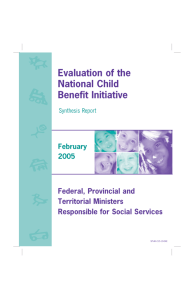Engaging young people as researchers
advertisement
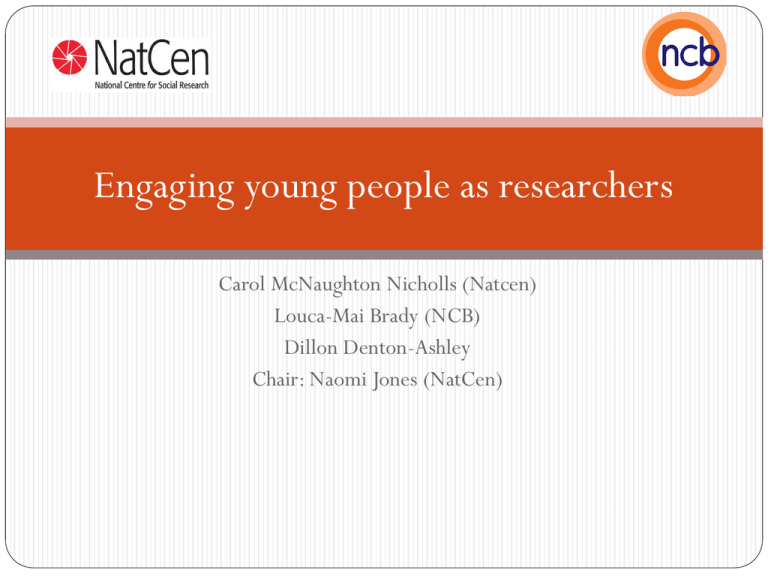
Engaging young people as researchers Carol McNaughton Nicholls (Natcen) Louca-Mai Brady (NCB) Dillon Denton-Ashley Chair: Naomi Jones (NatCen) Who we are Louca-Mai Brady, Senior Research Officer, NCB Research Centre NCB is the leading support and development charity for children, young people and families The NCB Research Centre has a varied programme of high quality research across NCB’s areas of interest In both NCB and the Research Centre promoting and supporting children and young people’s participation is a key aspect of our work Who we are Dr Carol McNaughton Nicholls, Research Director, Qualitative Research Unit, NatCen Naomi Jones, Research Director, Qualitative Research Unit, NatCen NatCen -Leading independent social research institute. Our work covers all areas of social policy and our aim is a society better informed through quality research. Large scale surveys, quantitative and qualitative research, often for central government. Who you are… Why you were interested in attending Any experience of engaging young people in research? Current or forthcoming projects Outline of session Definitions, benefits and principles of involvement Practical example from perspective of YP organisation Challenges of involvement – ideal, reality and pragmatism Practical example from perspective of research organisation Conclusion – checklist for involvement Drivers behind engagement of young people Consultation is the process by which children and young people are asked their opinions – on a specific issue or broader agenda (eg as research participants) Involvement/participation is the process by which individuals and groups of individuals can influence decisionmaking and bring about change (eg through involvement in the planning and process of research) Different roles Participant Young advisor Young researcher Young people/peer-led UN Convention on the Rights of the Child (UNCRC) Article 12 . Every child and young person has the right to express his or her views freely in all matters affecting them Article 13. Every child and young person has the right to freedom of expression, including the right to all kinds of information and ideas. Theoretical perspectives Involving those on whom research focuses on can have a positive impact on what is researched, how research is conducted and the impact of research findings (Staley, 2009) Shift from seeing CYP as subjects of research/ objects of enquiry towards a view of CYP as social actors with right to active participation (eg Grieg et al, 2007; Prout, 2002) Increasing acknowledgement of their competence to do so and the power of the ‘child voice’ in research (eg Alderson, 2001; Powell & Smith, 2009). Why is involvement important? Impacts on research: shaping research agendas to reflect those with greatest relevance; honing research designs, including ethical considerations and the appropriateness of language used; encouraging validation in the analytical process; and, when involved in dissemination, promotes trust in the research findings among the wider community. (Staley, 2009) Benefits for research Research topics and questions that are relevant to CYP’s lives Appropriate and accessible research methods and tools Involving young researchers can change the nature of data collected Increasing impact of research Developing understanding and bridging gaps between adults and CYP Benefits for children and young people Chance to be actively involved in issues that affect them Gaining recognition for their contribution Skills and experience Personal development Model of involvement in research Consultation (focus groups or one-off meetings at key stages of the research – eg to seek views on a research proposal) Collaboration (active, on-going participation – eg reference or advisory groups; young researchers working alongside adults on elements of a study) Young people-led (locus of power is with young people for some, or all, key elements of a study) Ladder of participation The NCB Research Centre model Children/young people's views are taken into account by researchers Children and young people have ownership of the research Children/young people are involved in decision-making with researchers Children and young people are the main stakeholders in research Based on Kirby et al. Building a Culture of Participation (2003) Questions and discussion What do you see as the benefits? For you/ the research For young people Methodological Epistemological Ethics and rights? Views on the model presented Practical example of CYP’s involvement – the PEAR group : our voices, our health A Wellcome Trust-funded project supporting 20 young people to contribute to UK public health research and policy Pilot project 11/2005 – 02/2008 Current project – 10/2008 – 11/2010 20 young people - meet in school holidays works to: Help young people to learn about, public health inform and influence research and policy Develop links between young people and public health researchers and policy makers Produce and distributing information about public health issues and research to young people Demonstrates the impact of young people’s involvement in public health research, and how this can be applied to policy and practice activity includes: Work with public health researchers, policymakers and research bodies (eg PHRC, NICE, INVOLVE) Website (www.ncb.org.uk/PEAR) Research summaries Conference (London, 27 Oct 2010) Speaking at events and conferences Responding to consultations Commissioning own research project Benefits – PEAR members’ views: Opportunities to learn about public health, gain research skills and have something to put on our CVs Having our voices heard by researchers and policymakers Helping to make research and policy more relevant to young people Letting other young people know about public health issues that affect them “We’ve been able to work with researchers and give our opinions. There’s a mutual benefit, we’ve helped them and also gained knowledge ourselves” “There’s lots of research about young people and public health – we deserve to have our voices heard” “It’s important that we’re involved [in projects like PEAR] as then our opinions are heard not assumed” “It’s important that we’re involved [in projects like PEAR] so that we can have an effect on young people’s public health policies” Other NCB involvement projects Developing the participation of disabled children and young people (2010-13) Involving Children in the Medicines for Children Research Network (2005 – on-going) Evaluation of Youth4U -Young Inspectors (2009 – 2011) Centre for Excellence and Outcomes (C4EO) young people-led research on impact of discrimination on educational attainment (2009) Young Researcher Network – young people-led research on ‘Media Portrayal of Young People: impact and influences’ (2008) National Review of CAMHS services (2008) What Makes the Difference? Peer research with care-experienced young researchers(2007) Questions on the PEAR project? Challenges of involvement Questions and discussion What do you see as the challenges? For you/ research For young people Methodological Epistemological Ethics and rights? When and why might you not involve young people in research? Availability Age and accrual Informed consent and the role of gatekeepers Safeguarding and child protection vs rights to participate Diversity and inclusive practice Resource implications Lack of experience Power issues Balancing young people’s & researchers’ expectations Quality and ethics Scepticism from researchers and research bodies Not always meaningful, possible or appropriate? Reality and the ideal: a pragmatic middle ground? Ideal Duration of project Reality P Project set up and recruitment R required before involvement Policy/funder objectives to meet Resource intensive – recruitment, training, support, admin High level of commitment asked for from peers, level of recompense? Lack of evidence regarding impact (Carr, 2004) Significant control over A decision making G M Training and support Unique standpoint privileged A T I S M Practical example of YP involvement: Formative evaluation of v V evaluation and peer researchers •Pragmatic approach to peer research involvement •V – youth volunteering agency V evaluation • Formative •Two and a half years • Mixed methods – strands include survey of grant recipients, omnibus survey, review of marketing, CBA, qualitative case studies, discourse analysis, analysis of monitoring data • Consortium • Involvement of young people central to v – desire to involve in evaluation V peer researchers Who are peer researchers: • Decision ‘peer’ – 16 – 25 with experience of volunteering • Recruited to reflect diversity/competency/interest • 12 peer researchers recruited at the end of 2009 • Residential Training weekend January 2010 What are they working on: Qualitative case studies • In depth case studies began March 2010 •Design of topic guides & fieldwork strategies for case studies February 2010 • In depth case study visits underway (lead sections of interviews etc) Preparing for involvement: Purpose of involvement: • Accountability • Quality • Learning Parameters of involvement • clarity of role and responsibilities - job spec • focus on in depth case studies data collection encounters with young people • constraints when designing & conducting social research Design of recruitment strategy Designing Training Training: Principles underpinning training: • Not making assumptions about ability levels • Making involvement as accessible as possible •Thinking flexibly & creatively about how best to offer support Training sessions: • Overview of Evaluation: • Introduction to Qualitative Research and QRU • Introduction to Qualitative Data Collection • Introduction to research ethics •Training delivery: Formal taught sessions •Group exercises – designing case studies. •Facilitation by external expert Support: •Assigning a peer researcher coordinator; payments and invoices; setting up processes and developing guidelines; maintaining general contact •Ensuring that the way we work with peer researchers meet existing organisational procedures •Data Security •Ethics/ Disclosure •Communication •Monthly newsletter •Mentor •Facebook •Training – regular sessions Mentor: •Facilitate peer researchers involvement by acting as the main point of contact •Monitor the time spent on tasks and the quality of work meets expectations •Establish a professional but supportive relationship with peer researchers •To assist and facilitate skills development Challenges Young person – researcher identity is on a continuum and changes over time Support and training v normalisation Availability Fieldwork skills Staff resources Research aims and design already set Inherently hierarchical manner of working A view from a young person Why involved Always been interested in society and social work Had previous interest in solving problems as a volunteer (volunteered for Turning Point and Media company working in the community) Why is it important Relate to young people Understand them – read between the lines More trusting towards other young people Young people trust the research findings more A view from a young person Challenges Time My challenges – finances, cannot be paid due to benefits College and priorities Lots to understand – will I make a fool of myself? Nerves Tips on how to involve young people Look at the background, if they cannot give them money try to give them something else. A view from a young person What do I want to gain from it: Experience Benefits of involvement: Honing research designs, including ethical considerations and a the appropriateness of language used. Shaping research agendas to reflect those with greatest relevance. a Encouraging validation in the analytical process. ? Involved in dissemination, promotes trust in the research findings among the wider community. ? Access to population and trust in the research a Capacity builds within organisation; Engages with wider community a Questions on the V evaluation? Conclusion: Checklist for involvement •Benefits to research as well as those involved •Planned from the outset •Recruitment – how, where, who and for how long •CYP involved in deciding if, when and how they want to be involved – and given all the information they need to do so •Informing parents or carers if under 16/18 •On-going training and support •Involvement in as many stages of research as possible •Involvement is accessible and relevant to those involved •Agree clearly defined roles •Genuine opportunities for meaningful decision-making •Reward and recognition (and challenges re: benefits) •Safe working procedures and ethics •Staff resources •Evaluation and feedback •Exit Strategy Discussion and questions why engage young people as researchers? why not engage young people as researchers? how could or should this apply to your own research? what are the implications for ESRC and other research funders? Further information www.ncb.org.uk/research www.ncb.org.uk/PEAR www.natcen.ac.uk www.invo.org.uk (INVOLVE – guides on payment, involving CYP and other information including recent report on impact) Participation Works: http://www.participationworks.org.uk/home Children’s Rights Alliance for England: http://www.crae.org.uk/rights.html National Youth Agency: http://www.nya.org.uk/integrated-youth-supportservices/young-researcher-network References Alderson, P. (2001) ‘Research by Children’. International Journal of Social Research Methodology, vol 4, no 2, pp 139-153. Greig, A., Taylor, J. and MacKay, T. (2007) Doing Research with Children. London: Sage Kellett, M. (2005). How to Develop Children as Researchers. London: Paul Chapman Kirby, P., Lanyon, C., Cronin, K. and Sinclair, R. (2003) Building a Culture of Participation: involving children and young people in policy, service planning, delivery and evaluation. London: DfES. Kirby, P. (2003) A Guide to Actively InvolvingYoung People in Research, for researchers, research commissioners and managers. Eastleigh: INVOLVE. Powell, M.A. and Smith, A.B. (2009) ‘Children’s Participation Rights in Research’. Childhood, vol 16, pp 124-142. Prout, A. (2002) ‘Researching children as social actors: an introduction to the Children 5-16 programme’. Children and Society, vol 16, no 2, pp67-76. Staley, K. (2009) Exploring impact: public involvement in NHS, public health and social care research. Eastleigh, Hampshire: INVOLVE
